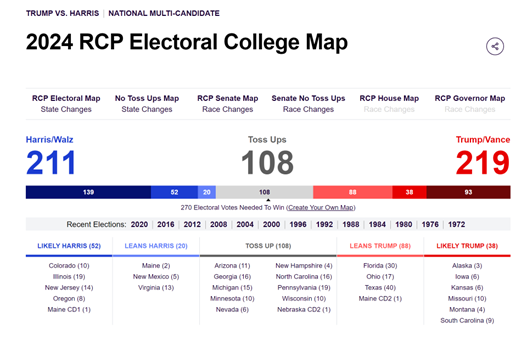US Elections too close to call with less than week before voting ends
This has been the most unpredictable presidential election in living memory. For the first time since Lyndon Johnson pulled his name from the nominating process, a sitting president decided not to seek another term. Johnson decided in March: Joe Biden withdrew four months closer to the election.
Donald Trump narrowly escaped an assassination attempt. He avoided judgement in three of the four major trials he faced this year (business fraud, mishandling of secret documents, attempting to overturn the US election, attempting to change the outcome of a US election). In the one case which was decided, the former president was convicted on 34 charges.
Despite a daily onslaught of news coverage, social media “revelations”, and daily fundraising requests, Americans’ opinions about the race stayed remarkably stable. Vice President Kamala Harris entered the race, opened a slight lead (by 3% in August) in national polling, and then watched as former president closed the gap incrementally (Harris now leads by 1.4%) over the final two months of the campaign. These minor shifts in polling all fell within the margin of error.
With the race so close, polls based on larger samples are better bets to give a better snapshot of the race. What those polls say is mixed. An AtlasIntel poll of 3000 likely voters between October 25-29th had Donald Trump up by 2%. A Morning Consult survey of 8000 likely voters conducted October 25-27th had Harris ahead by 3%. A 78,000 CCES/YouGov poll of adults (October 1-25) resulted in a 5% advantage for Harris.
The 538 website estimated that Donald Trump has a 52 in 100 chance of winning the election. Kamala Harris has a 48 out of 100 chance. If the margin of error in polling tilts their way, according to 538, Harris could win 319 electoral college votes and Trump 312 (270 is needed to be elected). In the so-called swing states that should determine who wins the election, Trump leads in North Carolina (+1%), Georgia (+1%), and Arizona (+2,2%); Harris leads in Michigan and Wisconsin (both +1%); Pennsylvania and Nevada are even.
Some experts remind us that polls underestimated Trump support in 2016 and 2020. Others predict that polling agencies have overcorrected for this mistake, and may now be underestimating the Harris vote. 538 warns that there is “ only about a 1-in-3 chance that polls miss by less than 2 points (which we (538) would consider a small polling error historically).”
We are not going to know until the votes are counted.


When will those votes be counted? It took four days after the election for Joe Biden to be determined as the winner in 2020. If the race is as close as the polls indicate, we can expect a similar delay this year. Legal challenges may keep the outcome in doubt even longer.
As for the Senate, Real Clear Politics predicts Republicans will increase their seats by 2. This is enough to give them a majority of 51-49.

In the House, Real Clear Politics predicts Republicans will win 201 districts and Democrats 192. That means whoever controls the House will be determined by the 42 districts that are too close to call a winner.

-wms-
